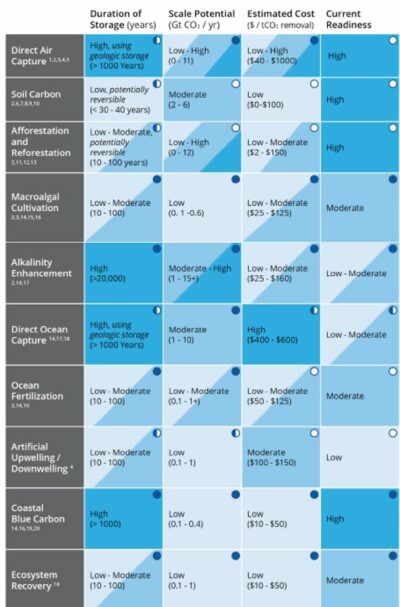January 26, 2023 — As the impacts of climate change become more visible in everyday life, attention is increasingly turning to ways to remove greenhouse gases from the atmosphere and so minimize further harm. A new report from the National Oceanic and Atmospheric Administration (NOAA) provides a valuable overview of various approaches to doing so.
In November 2020, NOAA’s Carbon Dioxide Removal Task Force was charged with looking at research needs around various carbon dioxide removal strategies, from direct air capture to boosting land and ocean ecosystems’ ability to absorb the gas. Its newly released report summarizes pros and cons of various approaches and describes what we need to learn and how NOAA can contribute.
Strategies assessed were:
Direct air capture: using absorbent material to trap CO2 from the air and then converting it into a substance that prevents it from easily escaping back into the atmosphere.
Soil carbon: boosting the ability of soil to store carbon.
Afforestation and reforestation: planting trees.
Macroalgal cultivation: farming CO2-absorbing seaweed or encouraging its growth in nature.
Ocean alkalinity: increasing ocean water’s ability to store carbon by increasing its pH.
Direct ocean capture: removing CO2 from ocean or other water so it can trap more.
Ocean fertilization: adding nutrients to ocean water to accelerate carbon uptake by photosynthesizing organisms.
Artificial upwelling/downwelling: bringing nutrient-rich water up from the depths of the ocean to the surface where it can feed carbon-trapping life forms and/or sending carbon-rich surface water to the depths.
Coastal blue carbon: Storing carbon that runs off upland areas or is absorbed by plants that inhabit ocean coasts in the soil.
Ecosystem recovery: rehabilitating ocean ecosystems to enhance organisms’ ability to absorb carbon and eventually store it on the ocean floor.
For each strategy, the group summarized research related to how long the approach could store carbon, its ability to scale, its relative cost and the extent to which it can be deployed with existing capabilities.
The figure below summarizes various attributes of the Carbon Dioxide Removal approaches assessed. The darker the blue shading, the more favorable the approach with respect to the attribute. Circles indicate NOAA’s ability to address the particular approach and attribute. Click the image to expand.
“[N]egative emissions strategies will be essential for keeping global temperatures at or below target levels,” the authors write. “Many of these techniques are promising in theory, but require additional research to evaluate their effectiveness and scalability, and explore potential co-benefits and environmental risk.”
Related Posts
Ensia shares solutions-focused stories free of charge through our online magazine and partner media. That means audiences around the world have ready access to stories that can — and do — help them shape a better future. If you value our work, please show your support today.
Yes, I'll support Ensia!




